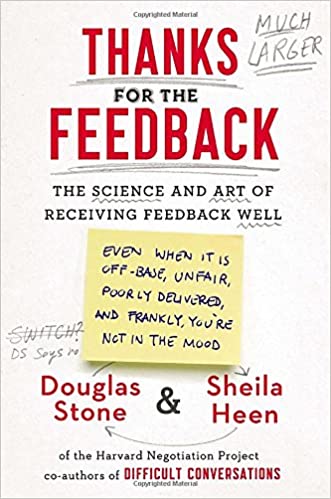Not all feedback is difficult. Most of us do just fine with positive feedback. Then there’s the tougher stuff –– the feedback that leaves us confused or enraged, flustered or flattened. This kind of feedback triggers us. Our heart pounds, our stomach clenches, our thoughts race and scatter. We usually think of that surge of emotion as being “in the way” –– a distraction to be brushed aside, an obstacle to overcome.
But pushing our triggered reactions aside or pretending they don’t exist is not the answer, Douglas Stone and Sheila Heen tell us in Thanks for the Feedback. Stone and Heen have spent more than a decade working with companies and non-profits trying to determine what helps people learn and what detracts from the learning process.
They’ve determined that triggers are obstacles, but they are also information that can help us locate the source of the trouble. Understanding our triggers and sorting out what set them off are the keys to managing our reactions and engaging in feedback conversations with skill.
Because feedback givers are abundant and our shortcomings seemingly boundless, we imagine that feedback can trigger us in a googolplex of ways. Actually, there are only three: truth, relationship and identity triggers.
(1) Truth Triggers are set off by the substance of the feedback itself –– it’s somehow off, unhelpful or simply untrue. In response, we feel indignant, wronged and exasperated.
(2) Relationship Triggers are tripped by the particular person who is giving us this feedback. All feedback is colored by the relationship between the giver and receiver, and we can have reactions based on what we believe about the giver or how we feel treated by the giver. Our focus shifts from the feedback itself to the audacity of the person delivering it.
(3) Identity Triggers are all about us. Whether the feedback is right or wrong, something about it has caused our identity to come undone. We feel overwhelmed, threatened, ashamed, or off balance.
Our triggered actions are not obstacles because they are unreasonable but because they keep us from engaging skillfully in the conversation. Receiving feedback well is a process of sorting and filtering –– of learning how the other person sees things; of trying on ideas that at first seem a poor fit; and ultimately, of experimenting. And of shelving or discarding the parts of the feedback that in the end seem off or not what you need right now.
Additionally, it’s not just the receiver who learns. During an effective conversation, the feedback giver may come to see why their advice is unhelpful, and both parties may understand their relationship in a new, clarifying light.
But it’s nearly impossible to do this from inside our triggers. And so, we make mistakes that cause us to put potentially valuable feedback into the discard pile, or just as damaging, we take to heart feedback that is better left at the curb.
Thanks for the Feedback will help you increase your self-awareness and develop more meaningful relationships with anyone that you receive feedback from. Read it today!
Soundview subscribers get 15-minute summaries of the key concepts in best-selling business books (like Thanks for the Feedback) delivered to them every week! Take your career to new heights by staying up-to-date with the trends and ideas affecting business leaders around the globe.





